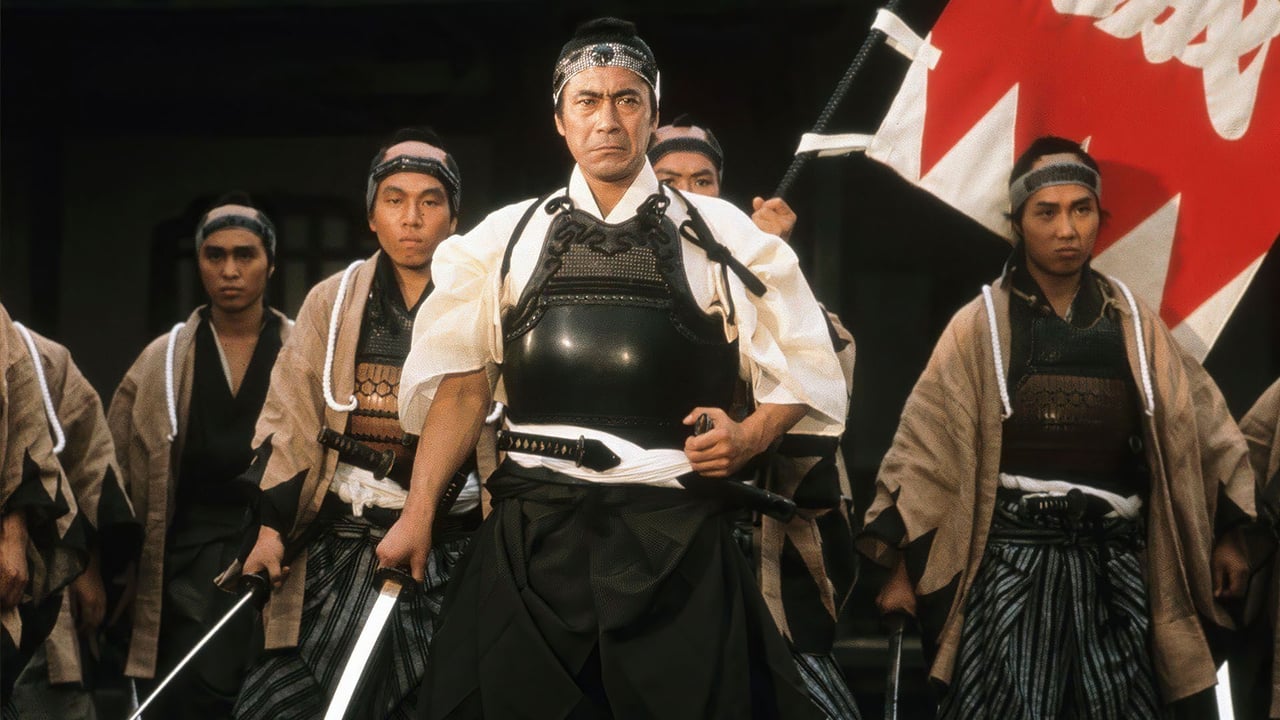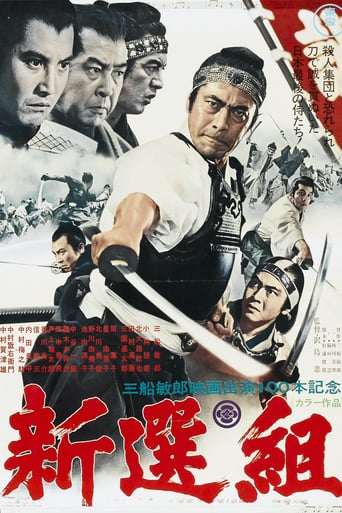

Waste of Money.
... View MoreTied for the best movie I have ever seen
... View MoreJust perfect...
... View MoreCritics,are you kidding us
... View More... a couple of slight historical corrections to previous reviews are in order. Firstly, although the Roshigumi (Ronin Corps) were formed to protect the Shogun during a journey to Kyoto to discuss recent political divisions with the Emperor, when they arrived at Kyoto their leader revealed that he actually wanted to take the Imperial side rather than the Shogunate side. This is why Kondo and the others split and formed the Shinsengumi (Newly Selected Corps). Secondly, although Kondo and some of the others were former farmers, they were all expert swordsmen. Kondo himself had been adopted into a samurai family and was headmaster of the Shieikan Dojo which taught Tennen Rishin style swordsmanship and several of his high ranking students and instructors had joined him in the Roshigumi and Shinsengumi. One in particular, Okita Soji is universally recognised as a "genius swordsman".Other than that I completely agree with the other reviews - this is a film well worth watching!
... View MoreI'm bursting with good things to say about this film. Japan's (maybe the world's) greatest actor playing one of Japan's greatest heroes is already goosebump inducing. In fact, all of the cast is stellar. As the other comments have pointed out, if you don't know the story of the Shinsengumi, you're at a disadvantage. This is a sort of Japanese Iliad, a real life story of heroism and tragedy. Everybody in Japan knows the names of the leaders of the Shinsengumi in the way that American children learn about George Washington and Benjamin Franklin. The good news is that the DVD program notes are fairly encyclopedic. They cover the major characters, places and events. Serizawa's entry mentions that "his hobbies include drawing, long fights on the beach and driving foreign invaders from his homeland." The film starts out well by including the ugliness of the Wolves of Mibu period. Hijikata is portrayed in a very dark way. Toward the end, Kondo actually says that Hijikata did all the dirty work so that Kondo could keep his hands (and soul) clean. Even though the Shinsengumi are the heroes, there is a point where you will be yelling at Hijikata to commit seppuku. The shogunate is a mess and you end up rooting for Kondo's devotion to the shogunal party at the same time that you want the shogunate to dry up and blow away. The film manages to be nuanced and yet get you jumping up and down yelling at your television.The production is beautiful, everything that you would want a samurai film to be. The costumes of the Shinsengumi are semi-accurate, unlike the beautiful but wrong ones in Gohatto. Although the pattern is correct in this film, the real colors were much more lurid. In real life, they must have looked like a troop of murderous peacocks as they charged through Kyoto. The exterior shots are gorgeous and the interior shots are lovely as well, although everybody seems to have brand new tatami at every point throughout the movie.
... View MoreThe year is 1863 and Japan is in a severe political upheaval. The Shogunate of the Tokugawa was fighting the murderous ideology of sonnō jōi: "Revere the Emperor, Expel the Barbarians", whose followers had began to commit acts of murder in Kyoto. In response to this, the Shogan formed the Rōshigumi; a group of 234 Ronin who were to protect the Shogan from harm.One of the leaders of this group was a man named Kondo Isami (Mifune), a man who would eventually dissent and go on to form the Shinsengumi. The former group, the Rōshigumi, became suspicious of the Shinsengumi and sent spies to infiltrate the organization. Henceforth the Shinsengumi not only had to deal with the task of protecting the Shogun, but also with treachery within their own group. This is the setting of Shinsengumi: Assassins of Honor, a carefully researched and violent historical piece set in 19th century Japan.Shinsengumi is an incredibly complex film. I must caution viewers that they might want to read up on the history of the time period before watching this film, if you choose not to, you might have problems following the plot. That being said, as complex as it is, Shinsengumi is just as good and rewarding.To be honest, I knew from the first shot of this film that it was going to be great. The opening shot is of a westerner being slain by a samurai, a torrential downpour of blood spraying into the camera. I have to say the first shot set my expectations high and I wasn't disappointed. After the bloody opener, the film slows down and sets up the highly intricate plot and then introduces the viewer to Isami (expertly played by Toshiro Mifune...as always).Isami is a former farmer and a ronin, who helps form the Shensengumi. After the current leader goes crazy from alcoholism, Isami slays him and becomes the head of the Shinsengumi. Once in power, Isami's finds out his troubles are just beginning.Personally, I don't think I've ever seen a bad performance by the late Toshiro Mifune and Shinsengumi is another testament to his great acting ability. As far as acting goes, Shinsengumi features a great acting ensemble; from Mifune down to Katsuo Nakamura's tragic portrayal of the clan's accountant.The only thing more exquisite than the acting is the wonderful detail poured into the set and wardrobe. Vivid colorful kimonos, haori's and hakam's abound contrasted with beautifully reconstructed 19th century Kyoto; add Kazuo Yamada's expert cinematography and Hiroshi Ueda's capable art direction and you have a historical epic.To be clear, Shinsengumi is not an action film. Although it contains it's share of action (the scene in the Ikeda mercantile factory is incredible!!!)it's primary focus is on character development and an objective look at the political and social problems of late 19th century Japan.Bottom Line-Director Tadashi Sawashima delivers a violent samurai masterpiece, with great acting, score, cinematography, and a flawless Mifune.
... View MoreSHINSENGUMI (aka BAND OF ASSASSINS, 1970) is a large-scale Japanese samurai drama based on actual events and historical figures. It tells the tale of what is essentially a paramilitary group of citizens who become swordsmen in the service of the Shogun in his conflict with the Emperor during the final years (1863-1868) of the Tokugawa Shogunate. This conflict, precipitated by the opening of Japan to the west, paralleled America's own Civil War, which happened roughly around the same time (1861-65). The result, in Japan, was the onset of the Meiji Restoration, which led to Japan restoring the Emperor to power, adapting to new knowledge from the west, and emerging as an industrial and world power in its own right.Toshiro Mifune stars as Isami Kondo, the noble and idealistic farmer-turned-swordsman who becomes chief of the Shinsengumi, as the group is known, after killing Serizawa Kamo (played by Rentaro Mikuni), the first chief, a samurai who had become corrupt and arrogant. The film follows key events and battles in the course of the period covered, 1863-69, and the shifts in the political winds, as the Emperor soon aligns himself with pro-western forces, the Shogun withdraws from the struggle, and the Shinsengumi find themselves declared outlaws and rebels despite the fact that the group had originally formed to combat rebels opposing the Shogun. All of this is seen through the eyes of Kondo, an honest but hardened man who has imposed on his men a strict set of samurai rules which require the act of seppuku (ritual suicide) by any of them if they break a rule. As he tries desperately to hold onto his obsolete code, his world comes crashing down around him and he and his men (and Japan) pay a huge price. At some point, it all must seem supremely futile to him, yet he trudges on, following his destiny to the sad, bitter end. The movie doesn't seem to take sides but simply presents scenes from the rise and fall of the Shinsengumi. Their values seem horribly outmoded even at the time the events are taking place and they seem to cause an awful lot of pointless death and destruction. Kondo is neither romanticized nor glamorized, although Mifune's portrayal certainly ennobles him as a sincere, loyal man who was simply swept up and engulfed in the tide of overwhelming historical and social forces that had been building up throughout the feudal era. Japanese viewers don't need a guide to the background story, since this is a piece of history that is rigorously taught in their classes. Non-Japanese viewers, however, may need to study a little before watching this film (and I don't mean watching THE LAST SAMURAI first), since it's never clear from the film what the differences are between the Shogun and the Emperor or why they're at war. Who's fighting who and why are questions not adequately answered for viewers not already familiar with the history behind the movie, so I would urge some research into the period first. There were a lot more issues at play than the question of Japan's impending modernization.This is one of the most important Japanese samurai films, although I would hesitate to group it with such other classic samurai films as SEVEN SAMURAI, YOJIMBO, the SAMURAI trilogy, SWORD OF DOOM and SAMURAI REBELLION, to name a few. There is no adventure here, no excitement or romance. The swordplay is not intricately choreographed. It is awkward, messy, and grueling, exactly the way it would be if undertaken by farmers-turned-inexperienced swordsmen. The only one who wields unmistakable skill in battle is Kondo, who is established as a farmer with years of sword practice and training of others. One of the new recruits is an accountant from an affluent family whose fate is particularly heart-wrenching and provides the turning point of the film. It's all masterfully photographed and staged, complete with a somber music score by veteran composer Masaru Sato. This is a film that should be seen by all those interested in Japanese cinema and Japanese history. I would particularly like to single this film out for fans of the Japanese animated TV series, "Rurouni Kenshin," and its made-for-video prequels (marketed in the U.S. as "Samurai X"), all of which touch on, in some way or other, the turbulent period covered by this movie. I should also point out that a live-action TV series entitled "Shinsengumi," on the same subject, premiered on Japanese TV in 2004.
... View More